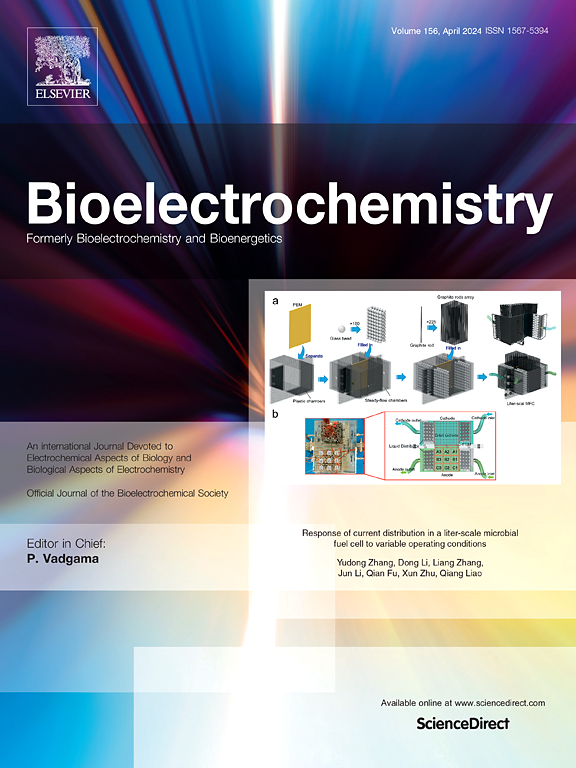Development of a CRISPR/Cas13a-based electrochemiluminescence biosensing strategy for sensitive detection of α-synuclein oligomers in neurodegenerative diseases
IF 4.5
2区 化学
Q1 BIOCHEMISTRY & MOLECULAR BIOLOGY
引用次数: 0
Abstract
In this study, we report a highly sensitive CRISPR/Cas13a-based electrochemiluminescence (ECL) biosensor for detecting α-synuclein oligomers, early biomarkers for neurodegenerative diseases. The system integrates aptamer recognition, T7 transcription, CRISPR/Cas13a cleavage, and EXPAR amplification. α-Synuclein binding triggers the release of the T7 promoter, leading to RNA production that activates Cas13a, initiating collateral cleavage and EXPAR, generating double-stranded DNA that interacts with [Ru(phen)₂dppz]2+ to produce a measurable ECL signal. The sensor achieved an ultralow detection limit of 1.025 aM with high specificity and stability. In serum samples, recovery ranged from 95.2 % to 99.8 %, demonstrating strong accuracy. No interference was observed from unrelated proteins. The biosensor showed excellent reproducibility (intra-day RSD = 0.78 %, inter-day RSD = 2.86 %) and stable performance over 14 days. Compared to other existing methods, this strategy offers superior sensitivity and comparable dynamic range, making it highly suitable for clinical use. Although the assay requires multiple steps and approximately two hours, the tradeoff is justified by its performance. This work highlights the potential of combining CRISPR/Cas13a with ECL for ultra-sensitive biomarker detection in complex samples, supporting early diagnosis and monitoring of Parkinson's and Alzheimer's disease.
基于CRISPR/ cas13的电化学发光生物传感策略在神经退行性疾病中α-突触核蛋白低聚物的灵敏检测
在这项研究中,我们报道了一种高灵敏度的基于CRISPR/ cas13的电化学发光(ECL)生物传感器,用于检测α-突触核蛋白低聚物,这是神经退行性疾病的早期生物标志物。该系统集成了适体识别、T7转录、CRISPR/Cas13a切割和EXPAR扩增。α-Synuclein结合触发T7启动子的释放,导致激活Cas13a的RNA产生,启动侧支切割和EXPAR,产生与[Ru(phen)₂dppz]2+相互作用的双链DNA,产生可测量的ECL信号。该传感器的检测限为1.025 aM,具有较高的特异性和稳定性。在血清样品中,回收率为95.2% ~ 99.8%,具有很强的准确性。未观察到不相关蛋白的干扰。该传感器具有良好的重现性(日内RSD = 0.78%,日间RSD = 2.86%), 14 d内性能稳定。与其他现有方法相比,该策略具有更高的灵敏度和可比较的动态范围,非常适合临床使用。虽然该分析需要多个步骤和大约两个小时,但其性能证明了这种权衡是合理的。这项工作强调了将CRISPR/Cas13a与ECL结合在复杂样品中进行超灵敏生物标志物检测的潜力,支持帕金森病和阿尔茨海默病的早期诊断和监测。
本文章由计算机程序翻译,如有差异,请以英文原文为准。
求助全文
约1分钟内获得全文
求助全文
来源期刊

Bioelectrochemistry
生物-电化学
CiteScore
9.10
自引率
6.00%
发文量
238
审稿时长
38 days
期刊介绍:
An International Journal Devoted to Electrochemical Aspects of Biology and Biological Aspects of Electrochemistry
Bioelectrochemistry is an international journal devoted to electrochemical principles in biology and biological aspects of electrochemistry. It publishes experimental and theoretical papers dealing with the electrochemical aspects of:
• Electrified interfaces (electric double layers, adsorption, electron transfer, protein electrochemistry, basic principles of biosensors, biosensor interfaces and bio-nanosensor design and construction.
• Electric and magnetic field effects (field-dependent processes, field interactions with molecules, intramolecular field effects, sensory systems for electric and magnetic fields, molecular and cellular mechanisms)
• Bioenergetics and signal transduction (energy conversion, photosynthetic and visual membranes)
• Biomembranes and model membranes (thermodynamics and mechanics, membrane transport, electroporation, fusion and insertion)
• Electrochemical applications in medicine and biotechnology (drug delivery and gene transfer to cells and tissues, iontophoresis, skin electroporation, injury and repair).
• Organization and use of arrays in-vitro and in-vivo, including as part of feedback control.
• Electrochemical interrogation of biofilms as generated by microorganisms and tissue reaction associated with medical implants.
 求助内容:
求助内容: 应助结果提醒方式:
应助结果提醒方式:


